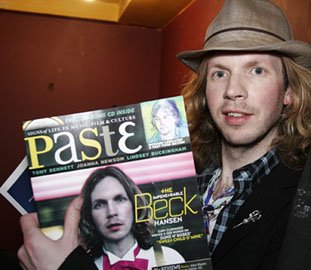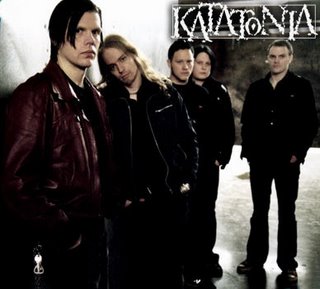Here's a short interview I did with Anneke from The Gathering about their new album
Home, due out April 18. It also includes information about their latest North American tour, which started at SXSW, traveled through NYC and ended in Toronto.
JP: How was SXSW?
Anneke: It was nice, but of course it’s like an ant’s nest of all these people and bands and VIPs and it’s overwhelming. We unpacked and played and went on again. We look quite double towards it. It’s good for your resume and it’s a quite important festival, but on the other hand we played on a very small, well, we didn’t have a stage. We had to lose some instruments because not everything fits on the stage. So it’s really a bunky runky show, which is all right. It went well. But for us, it’s not an epiphany of what you do when you’re in a band.
JP: How have you been enjoying the rest of your tour besides being tired?
Anneke: We started in South America, which for us is very, very good. That was fantastic and we enjoyed all these countries. We went to a few different ones in Mexico and that was just fantastic. And we went to North America, which is a bit more heavy for us because we have to travel so much. We had one ride for 35 hours, so that’s just silly, but that, I think is just a logistical bookers problem. For the rest when we actually got to play, it was really nice. People are so, so great here. In America there’s a huge under toe stream of people who really appreciate art and music and they come to see The Gathering and it’s just fantastic. Yesterday people were wild. I like that, it’s great. People in New York are crazy.
JP: A talked to a few people last night [at the Knitting Factory in New York City] that said they traveled from California for the show.
Anneke: We had a few people that traveled with us all three days, they traveled to the shows. Since North America is very widespread, big, huge country, we have to travel a lot, but people come see us. That’s amazing that people take the time and effort to come see us.
JP: Do you think you might be back after the record [Home, release date April 18] comes out?
Anneke: I hope so. I hope in a bit better conditions because this has been kind of unhealthy and dangerous to drive like that. For us, we want to make good shows. We want to do everything possible to make that happen. So we should make more of an effort logistically and we should come back. We really want to go to the West coast again as well because it’s very good playing there as well.
JP: I know you’ve worked with the same producer before, Atti Bauw. You worked with him on How to Measure a Planet. What was it that made you want to work with him again?
Anneke: We are very proud of How to Measure a Planet. For us it’s one of the best records and we feel very proud of it still after these years. Working with him was a great experience because he looked at music in a whole different way. He’s one of the first to work with Pro Tools on this recording and we learned so much and it was a great time. For some reason we just thought of him again now when we were thinking about producers. Hans, our drummer, he said, “How about Atti.” We stayed in contact so we knew kind of where he was living, and we called him and asked if he had time and he immediately came with all cool ideas he felt really up to it. So we discussed some things and we brought music, we let him hear what we had until that time and he really liked the songs. Immediately it was just great to be with him again because he’s just full of ideas. He’s a great guy and he’s relaxed. He takes his time for things to develop. He really fits with our music. Working with him again was really wonderful.
JP: What were some of the things that you carried over from How to Measure a Planet and what were some of the things you were trying to do differently?
Anneke: The thing that was most important with the album was we wanted to make the songs really pure and close to the heart. Souvenirs was very produced. It was very layered, a lot of details, very beautiful. But you cannot top that. You cannot go beyond that because we did that. You have to take on a new approach. We felt the new record should be more pure and close the heart. The songs that were already written when we went into the studio were very personal and very pure. Atti, he really made it happen in the studio. Things changed so much because then you really hear what you’re playing and you really get to bottom of the core of the song. So that was for us the big thing that Atti helped us with. He really cut through the core of the song. When we would have three guitar parts and three vocals parts and three this and that—because he has a lot of ideas, he put them on the demo—he just scraped off a lot of things. This is beautiful, but it’s not really making the song more beautiful so it has to go. You really get down to what the song’s all about and that’s the most important thing he does.
JP: The compositions you had going into the studio, did they change a lot?
Anneke: They did because I think we made songs and we demoed them, but when we were in the studio we just undressed them again. We rehearsed in the morning; we would rehearse the songs acoustically with no amplifications. We would make drums on the hands and knees and just a small guitar and that’s it. Then we would play the song and we would recognize if the beat was good or the vocal line was good if the chorus was long or short or whatever. We would rehearse it acoustically. Then we would rehearse it in the afternoon amplified on the studio ground. And then in the evening we would record. So in one day the song could change or just its rhythm could change, so it would have a totally different approach, a better one than we had before because we stripped it down again.
JP: You built your own recording studio for this record?
Anneke: No. We went to a little church in Holland. We rented a little church and we put all our gear in there and built a studio.
JP: Okay. Why did you guys decide to do it that way?
Anneke: Well, we wanted to do something different to give us inspiration. When you make a record every year or two years you just see kind of a lot of studios and in the end their all the same and you have to leave at one point because they close in the evening. So we wanted to go to one place where we could be. We were there a month and we lived and slept there and we just worked. The thing is that when we had a good idea we could just work on it or record it or whatever, so that was really nice. Also, so we had one floor on which we were recording and then eating and then there was a sitting area. And then upstairs was a sleeping area, but also in the sleeping area we made two small studios—studio two and three, we called them—with just two computers on the table, so when Rene or I or anybody had an idea for vocals or guitar we could record it on hard disc upstairs. So we could work simultaneously on songs or on guitars and drums at the same time or whatever. So there was always a process going on of getting ideas down on tape or on the computer. And then when they would be good enough, they fit the song, then we would import them to studio one again on the hard disc. So that was really nice, because when we felt like it would could record something or read a book or go to sleep or make music. That was really nice. And the surroundings were also very quiet because it was a very small village with three churches and four hairdressers and that was it and one store. When we would go outside there was nothing there just meadows and water and a few houses so you were not distracted. You would just go outside and get a fresh nose and come back and make music again. For us it was a good time.
JP: The next DVD that you are putting out, you are going to name it A Noise Severe, is that right? If I do say so, it’s a nice compliment to A Sound Relief. I was wondering where you came up with the concept of doing it that way.
Anneke: Because The Gathering has a few faces. We have a very mellow side, but we have a bit of more rocky, doomy side, so we just wanted to split those two up for once, you know, for fun, and to make a DVD which we made A Sound Relief with more mellow side of The Gathering, more soft songs. Also, we wanted to make one with more heavy songs, a more rocky side of us. We are touring right now with a more rocky show and at one point we want to record that and put it out on DVD so you have a collection of two sides of The Gathering.
JP: I know that you guys set up your own label a few years ago and you are getting distributed on The End. Having your own label gives you a lot of artistic control. I was wondering why it’s so important for you to have that amount of creative control.
Anneke: For us it’s important because for us all about the music. We want to make songs and not products that people will buy. That’s another side of it, which is important because we like to sell and play and earn a living actually off our music. But one main core thing should be making good, beautiful quality music. Sometimes it’s hard when people have a big interest making money off of it. So for us it’s just nice to have control over when we make an album, how we make it, how long it will be, how it should, which producer. All these creative decision should be made by us and then from there you try to sell it in the market and blah, blah, blah. I believe there will always be an audience who likes it because it’s honest music and it touches hearts because it comes from the heart. But the way to find an audience is, of course, difficult, so you need help. Of course we have a small label because the only band we have is The Gathering. So we don’t really don’t have the power to put ourselves in the market. We have some help with Sanctuary and The End Records that just help up with promotion and stuff. That’s a good way of working together.





























